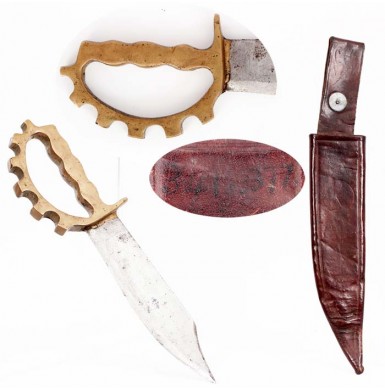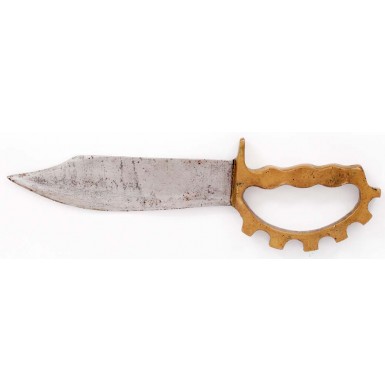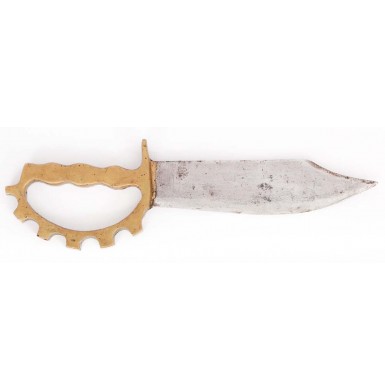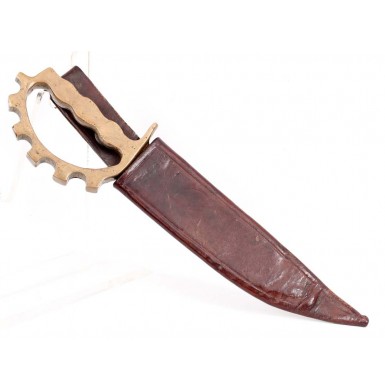1st Battalion Ranger Knife - Rare Smaller Variant
- Product Code: EWSK-1352-SOLD
- Availability: Out Of Stock
-
$1.00
This is a VERY FINE example of a very scarce variant of a World War II “Theater Knife” that spent a good part of its collectible lifetime misidentified. Ever since the publication Harold Peterson’s American Knives in 1958, the brass gripped “Knuckle Knife” of this pattern has been identified as the 1st Battalion Army Ranger’s Knife. However, the fact that a handful of these rather scarce knives have surfaced with markings indicating that their origin was in fact Australia, makes it clear that these knives could have never seen service with an Army Ranger battalion that spent its entire World War II career in North Africa, Sicily and Italy! Due to Peterson’s identification of this pattern of knife as one that was issued to the famous Army Ranger unit, these knives will no doubt continue to be referred to by that name. They are, however, in reality simply very wicked and impressive theater knives that likely saw service in the Pacific Theater, or were simply purchased as souvenirs by US servicemen who visited Australia during the war. The knives were produced in two different sizes. The more commonly encountered variant is about 14” in overall length with a blade of slightly over 9”. These massive “D-guard” bowies evoke the image of oversized Confederate bowie knives from the American Civil war, and Crocodile Dundee saying, “You call that a knife, THIS is a knife!”. The size of these knives made them heavy and cumbersome to carry, and they were probably more useful as machetes than as fighting knives. However, a smaller variant of the knife was also produced, and these knives were of the size and weight that made a real, useful fighting knife. These knives were scaled down versions of the big knife, and were about 2/3 the size of their big brothers. For whatever reason, the smaller version of the knife is much more difficult to find for sale today, although neither version of the knife is common.
This Small Variant “1st Battalion Ranger’s Knife” is in about VERY FINE condition. The knife is about 10 3/8” in overall length, with a 6 ““ bowie style blade with a 2” false edge and an overall width of about 1 ““ at the widest portion of the blade. The brass knuckle guard and hilt is about 4” in length, and the exterior of the guard is augmented with 6 flat cog-like projections to make the “brass knuckle” portion of the guard more effective. The brass hilt appears to have been cast directly onto the blade, and some brass has flowed onto the blade during the casting process. This is a good thing, as this particular feature is only noted on authentic and correct examples of these knives. Reproductions and fakes do not show the flowing brass on the blade at the ricasso. The projections are roughly filed into shape and the rough finished file marks are clearly evident within the projections of the grip. The interior of the knuckle bow shows rough hand finishing, although the edges of the grip interior have smoothed from handling and use over the years. The grip also shows some minor casting flaws and some minor discoloration, which is the result of some imperfections in the brass. The blade is mostly bright and retains much of its original polish. There are a handful of scattered patches of minor peppering and pinpricking present on the blade. The blade also shows some minor age discoloration and light surface oxidation. The blade has been sharpened and shows some light sharpening marks along the edge. The sharpened edge and the smooth areas worn on the grip edges suggest that unlike most of the big variants of this knife, this small one saw real combat carry and use. The brass hilt has a lovely uncleaned and untouched ochre patina that is truly attractive. The correct and original leather sheath accompanies the knife as well. Like the knife, it is a scaled down version of its big brother. The sheath is in about VERY FINE condition and fits the knife perfectly. The sheath has a belt loop that would originally accommodate a belt of about 3 1/8” in width. However, a 5/8” aluminum rivet has been installed in the loop to tighten it up and adjust the belt loop to accept belts no larger than about 2”. This modification also suggests that this knife was really carried and saw service. All of the stitching is tight and the leather remains strong and pliable, with only some light scuffing on the surface. The slightly over long and dramatically tapered scabbard tip is somewhat bent and shows some wrinkles and stress marks from bending. The scabbard is marked in ink at the throat with a faint, 7-digit number that is not fully legible and may be a service serial number. The same scabbard patterns, along with the knives, are depicted in most of the regularly cited reference works on American combat and fighting knives, including those by M.H. Cole, Michael Silvey and Bill Wright.
Overall this is a choice example of a very desirable and extremely nice condition World War II “Theater Knife” that has a long history of being misidentified. The knife has terrific eye appeal and would certainly make a great addition to any World War II knife or edged weapons collection. Its not a the 1st Battalion Army Ranger’s Knife, and there probably is no such thing. However, it is still a fantastic piece of World War II edged weapon history and its appearance and condition will certainly make it a conversation-starting centerpiece of your knife collection. These small variant knives are much rarer than their larger brethren and are rarely found for sale.




